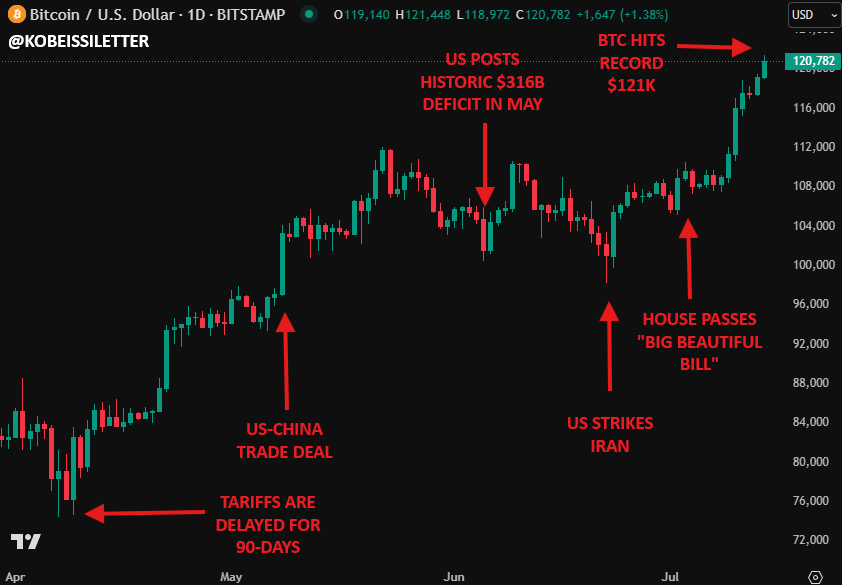Bitcoin hit a new all-time high of $123,400 on Monday after massive ETF inflows

Bitcoin broke through $123,000 on Monday, setting a fresh all-time high as the crypto market added over $1.2 trillion in value since April 9th, when President Donald Trump ordered a pause on reciprocal tariffs.
The price of the OG crypto reached $123,400, based on data from CoinGecko, with the rally fueled by aggressive inflows into Bitcoin ETFs and growing bets from institutional players. The way it’s been moving, it’s literally been printing all-time highs multiple times a day.
The biggest jolt came Thursday, when Bitcoin ETFs recorded $1.18 billion in daily inflows, the highest of the year so far. Investors have been piling in with expectations that Bitcoin would set new records in 2025, especially as corporate treasuries continue buying and Congress gets closer to approving crypto legislation.
Spending bill, deficit, and ETF inflows send Bitcoin up $15K
The surge started gaining speed after the House of Representatives passed Trump’s so-called “Big Beautiful Bill” on July 3rd. Since then, Bitcoin has jumped more than $15,000, climbing in almost a straight line with barely any pullbacks. It’s reached the point where the crypto is hitting all-time highs multiple times a day.
Before that, the turning point was April 9th, the day the White House announced the 90-day tariff pause. From that moment, Bitcoin and the U.S. Dollar Index (DXY) began pulling in opposite directions. That same week, market watchers noted that gold was rising, yields were climbing, and Bitcoin was taking off. At the same time, the dollar was slipping, adding more fuel to the crypto fire.

The pressure kept building when government numbers revealed a $316 billion U.S. deficit in May 2025, the third largest monthly deficit ever recorded. That number landed just as Elon Musk began publicly resisting another round of federal spending. But optimism didn’t last. Into July, Bitcoin was rising whether any trade deal happened or not.
Meanwhile, the S&P 500, when measured in Bitcoin, is down 15% year-to-date. And since 2012, that same index has dropped 99.98% in Bitcoin terms. That signals more than just a price rise, because it shows how far Bitcoin has outpaced traditional markets during financial instability. The trend lines are clear: Bitcoin is going up, the dollar is going down, and gold is moving with it.
Congress opens ‘Crypto Week’ as funds move into BTC
On Monday, the House of Representatives kicked off what’s being called “Crypto Week”, with a string of crypto bills up for discussion. These proposals aim to define how crypto will be regulated going forward. Clarity like this is what hedge funds, family offices, and even traditionally conservative investors have been waiting for. And they’re not wasting time.
Major players have already started moving parts of their assets under management into BTC, often targeting a 1% allocation. That number may seem small, but when applied to billions in capital, it’s massive. With ETFs now regularly attracting inflows and legislation finally entering the pipeline, crypto is no longer being ignored.
Traders watching the charts say this is not a normal market. Bitcoin has entered crisis mode. Not because it’s crashing, but because it’s thriving in a broken system. The irony? Cutting the U.S. deficit would likely fix a lot, lower rates, reduce inflation, and even strengthen the dollar. But no one believes that’s coming.
Instead, what’s happening is this: Bitcoin keeps gaining, and it’s not waiting around for policy to change. Even without a final trade deal or a passed bill, the pattern is obvious. Deficits go up, the dollar weakens, risky assets get a boost, and Bitcoin leads the way.
* The content presented above, whether from a third party or not, is considered as general advice only. This article should not be construed as containing investment advice, investment recommendations, an offer of or solicitation for any transactions in financial instruments.


